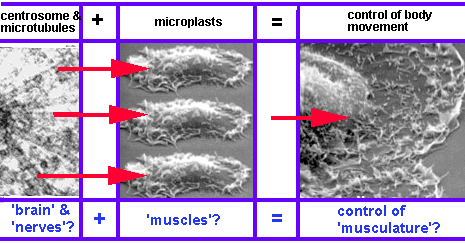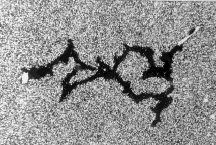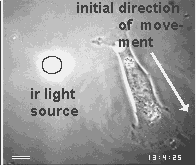CELL INTELLIGENCE
Guenter Albrecht-Buehler, Ph.D.
Fellow, European Academy of Sciences, Brussels
Fellow, Institute for Advanced Studies, Berlin
Robert Laughlin Rea Professor Emeritus of Cell Biology
Northwestern University Medical School, Chicago
SUMMARY.
THE NEED FOR CELL INTELLIGENCE
Nobody in his right mind would believe that the contractile protein
molecules in a person's throat speak English. Clearly, the molecules
follow orders issued ultimately by the person's brain. This is not a matter
of the size of the organism. The contractile proteins in the muscle cells
of a small nematode are not gliding or swimming, either. They, too, receive
orders from the nervous system of the worm. In short, the interactions
between the molecules of any organism generally do not create the
functions of the organism, but it is the other way around: The functions
of the organism initiate and control the interactions between its molecules.
The
necessity for such control is obvious. Using the example of contractile
proteins, the molecules can only polymerize, depolymerize or slide along
each other, but they would not know when and with what force and when to
stop. A signal-integrating mechanism is required.
Why should the situation be different for single cells? After
all protozoa are in effect small, but quite universal organism and the
above conclusion should apply to them as much as to a fly, a frog or the
author of this website. Yet, the vast majority of today's biologists
devote their efforts to prove the opposite, namely that specific molecular
interactions create the cellular functions such as cell division,
directed locomotion, differentiation, design of the extracellular matrix,
adhesion to materials and other cells and so forth.
My research for the past 30 years or so was devoted to examine
whether cells have such signal integration and control center(s).
The results suggest that mammalian cells, indeed, posess intelligence.
The experimental basis for this conclusion is presented in the following
web pages.
The most significant experimental results are:
1. The motile machinery of cells contains subdomains ('microplasts')
that can be isolated from the cell and then are capable of autonomous
movements. Yet, inside the cell they do not exercise their ability. The
situation is comparable to a person's muscles that are capable of contraction
outside a person's body, but do not contract at will once they are part
of the person, suggesting that they are subject to a control center.
2. The cell as a whole is capable of immensely complex migration
patterns for which their genome cannot contain a detailed program as they
are responses to unforseeable encounters ( Cell
movement is not random.. ).
3. Cells can 'see', i.e. they can map the directions of
near-infrared light sources in their environment and direct their movements
toward them. No such 'vision' is possible without a very sophisticated
signal processing system ('cell brain') that is linked to the movement
control of the cell. (The
larger their light scattering, the larger the distance from which aggregating
cells came together. )
In addition there is the supporting theoretical consideration
that the hiterto completely unexplained complex structure of centrioles
is predicted in every detail if one asks what structure a cellular 'eye'
should have. ( The structure of a pair of centrioles suggests their function as cellular eyes.)
MINDSET
Depending on the direction in which one reads the next sentence, intelligence
is a fractal property
or/and an emergent property:
...Intelligent
ecologies contain intelligent populations,which contain intelligent organisms,
which contain intelligent cells, which contain intelligent compartments,
which contain...and so forth.
MAIN HYPOTHESES
A. Cells control the movement of every part of their body.
Cell movement is not random..
The cortex consists of autonomous domains ('microplasts')
whose movement is controlled by a control center (centrosome). Microtubules
mediate between the control center and the autonomous domains.
B. The control center detects objects and other cells by fluctuating
near-infrared signals.
Cell have 'eyes' in the form of centrioles..
They are able to detect near infrared signals and steer
the cell movements towards their source.
APPROACH
For the past 2 decades I have applied essentially two lines of reasoning
to examine whether cells are intelligent. They can be summarized in the
following statements:
A. If cells can measure space and time, they must be able to derive
abstract data from physical signals.
Space and time are not physical objects with which cells could interact,
but they are the pre-condition of all physical objects. If cells can measure
space and time variables such as angles, distances, curvatures or durations,
they must have derived these abstract quantities from the physical objects
of their environment. Chapter 2
will use the apparent symmetry and identity between the branches of the
phagokinetic tracks of
dividing cells (an example is shown below) to argue that cells are programmed
to measure angles and time durations.

(The illustration is animated.Click
here for a minimal strip of frames.)
B. If cells have eyes, they must be able
to order and integrate countless signals.
Images are the ordered set of a huge number of individual data. If
cells are capable of generating an image of their environment and react
to it, they must be able to order a large number of signals and integrate
them into a response action. Chapter
3 will present the evidence that cells use centrioles
to 'see' all objects around them that emit or scatter near infrared light.
The figure below shows one of the examples of this amazing ability of cells.

(The illustration is animated.Click
here for a minimal strip of frames.)
HISTORICAL NOTE
To the best of my knowledge, the term CELL INTELLIGENCE was coined by Nels Quevli in the year 1916 in his book entitled
"Cell intelligence: The cause of growth, heredity and instinctive actions, illustrating that the cell is a conscious,
intelligent being, and, by reason thereof, plans and builds all plants and animals in the same manner that man constructs
houses, railroads and other structures." (The Colwell Press, Minneapolis, MN). The basic tenet of the book is that the actions
and properties of cells are too amazing to be explained by anything but their intelligence. (Similar sentiments are repeated today,
90 years later, by the followers of the so-called "Intelligent Design" movement, to which I do not subscribe.) With my apologies to the father of the concept of CELL INTELLIGENCE, I disagree with his approach. What scientists find "amazing" or "inexplicable" has always been and will always remain a matter of the date.
My work over the past 30+ years is not based on any philosophical positions but is entirely experimental. As summarized in this web site, it presents
novel assays demonstrating that cells coordinate their bodies during movement and respond to physical and topological parameters which are too weak to have caused the observed reaction by force.
These responses are then analyzed and used to identify the nature and location of a cellular data-integration system that may be responsible for these actions.




